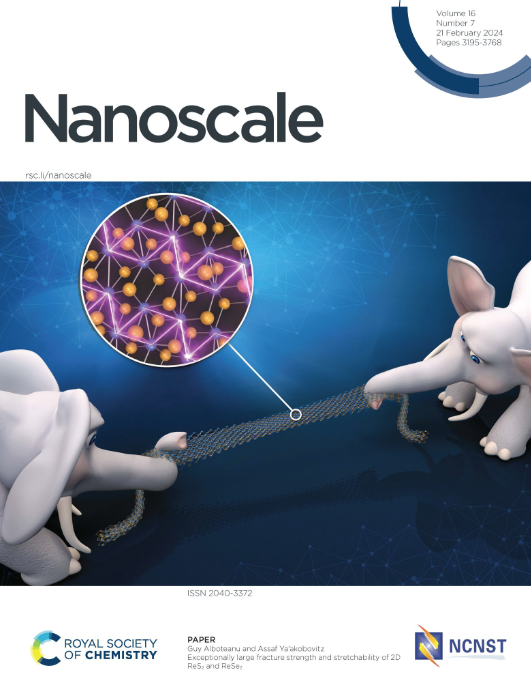Potential relationship of spin magnetic moment with thermal conductivity and catalytic performance in Fe-Co bimetallic catalysts: a machine-learning interatomic potential and density functional theory study.
IF 5.8
3区 材料科学
Q1 CHEMISTRY, MULTIDISCIPLINARY
引用次数: 0
Abstract
The thermal transport properties of catalysts are important for the stable operation of proton exchange membrane fuel cells. In this study, density functional theory and moment tensor potentials are used to solve the Boltzmann transport equation and investigate the thermal transport properties of various designed configurations of Fe-Co bimetallic catalysts, which are the most promising non-noble metal catalysts for the oxygen reduction reaction (ORR). It is found that the velocity of the phonon group in the y direction is always higher than that in the x direction, which leads to the anisotropic thermal conductivity of these catalysts. The uniformity of the thermal conductivity exhibited by bimetallic catalysts is better than that of single-metal atom catalysts. In the designed configurations, G-FeCoN6-3 is found to show a high thermal conductivity value (55.57-376.98 W m-1 K-1), which is even higher than that of G-FeN4 (35.66-132.75 W m-1 K-1). The analysis of phonon transport properties shows that the difference in thermal conductivity is mainly due to the difference in the phonon lifetime. The results indicate that thermal conductivity is governed by low-frequency phonons and the size effects are intensified in bimetallic catalysts. It is revealed from results on electronic structures that the low thermal conductivity may be related to the existence of band gaps in valence bands. Furthermore, these structures exhibit superior electrical conductivities with values of 0.98-2.2 × 104 Ω-1 m-1. Additionally, through the results of the maximum electron thermal conductivity of these structures, it is revealed that the thermal conductivity of these catalysts is mainly dominated by the lattice thermal conductivity. Finally, a potential relationship of spin magnetic moment with the thermal conductivity and catalytic performance is revealed.Fe-Co双金属催化剂中自旋磁矩与热导率和催化性能的势关系:机器学习原子间势和密度泛函理论研究。
催化剂的热输运性能对质子交换膜燃料电池的稳定运行至关重要。本研究利用密度泛函理论和矩张量势求解Boltzmann输运方程,研究了不同设计构型Fe-Co双金属催化剂的热输运性质。Fe-Co双金属催化剂是最有希望用于氧还原反应(ORR)的非贵金属催化剂。发现声子群在y方向上的速度总是高于x方向上的速度,这导致了这些催化剂的热导率各向异性。双金属催化剂的导热均匀性优于单金属催化剂。在设计的构型中,G-FeCoN6-3具有较高的导热系数值(55.57 ~ 376.98 W m-1 K-1),甚至高于G-FeN4 (35.66 ~ 132.75 W m-1 K-1)。对声子输运特性的分析表明,热导率的差异主要是由于声子寿命的差异。结果表明,双金属催化剂的热导率受低频声子控制,尺寸效应增强。电子结构分析结果表明,低导热系数可能与价带中存在带隙有关。此外,这些结构表现出优异的电导率,其值为0.98-2.2 × 104 Ω-1 m-1。此外,通过这些结构的最大电子热导率的结果,揭示了这些催化剂的热导率主要以晶格热导率为主。最后,揭示了自旋磁矩与热导率和催化性能的潜在关系。
本文章由计算机程序翻译,如有差异,请以英文原文为准。
求助全文
约1分钟内获得全文
求助全文
来源期刊

Nanoscale
CHEMISTRY, MULTIDISCIPLINARY-NANOSCIENCE & NANOTECHNOLOGY
CiteScore
12.10
自引率
3.00%
发文量
1628
审稿时长
1.6 months
期刊介绍:
Nanoscale is a high-impact international journal, publishing high-quality research across nanoscience and nanotechnology. Nanoscale publishes a full mix of research articles on experimental and theoretical work, including reviews, communications, and full papers.Highly interdisciplinary, this journal appeals to scientists, researchers and professionals interested in nanoscience and nanotechnology, quantum materials and quantum technology, including the areas of physics, chemistry, biology, medicine, materials, energy/environment, information technology, detection science, healthcare and drug discovery, and electronics.
 求助内容:
求助内容: 应助结果提醒方式:
应助结果提醒方式:


